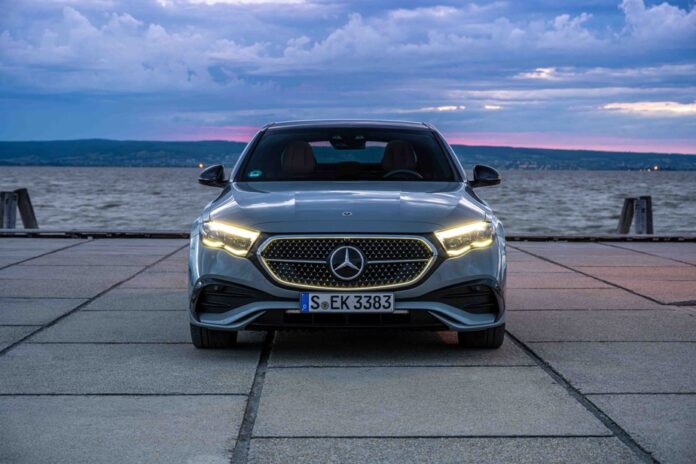(Vienna, Austria) At Mercedes, we don’t rush anyone. While creating a range of fully electric vehicles, the star firm keeps in mind that some of its customers will take longer to increase their “wattage”. Hence this generation of the E-Class.
Electric vehicles don’t connect everyone. And until the authorities force them, consumers intend to swear loyalty to the good old internal combustion engine for a while. And the E-Class, Mercedes’ most popular model, intends to satisfy these die-hard loyalists. But, in doing so, the star firm also ensures that it supports them towards the inevitable transformation of the E-Class into a “wattage” and not a car. This transition is already underway. In North America, the EQE, the electric counterpart of the E-Class, is preparing to take over (see our boxes). In Europe, it is more complicated. Indeed, Mercedes offers European consumers a much wider range of engines (petrol, diesel, plug-in hybrid).
With us, the future E-Class – its marketing begins next February – limits its offer to gasoline engines with four (350) or six (450) cylinders. Both are turbocharged. And both benefit from the assistance of a hybrid device (48 volts) whose primary mission is to reduce the response time (turbo) and soften the operation of the automatic cut-off system when stopped. The consumption ? Yes, but not so much. With the six-cylinder (450) at the very least, the only one of the two engines intended for the North American market present at the international preview.
In addition to a limited range of engines, Mercedes’ North American management is sacrificing the family version. A decision that aesthetes will deplore, but which no longer has to distribute an unprofitable vehicle. “If all the journalists who voted for it had bought one, it would probably still be in our catalog today,” jokes Zakary Paget, communications manager for Mercedes-Benz Canada.
By revisiting the E-Class, its designers have taken care to correct certain flaws of the past. And create new ones too! The flowers first. This mid-size luxury sedan now rides on a longer wheelbase that primarily benefits the rear seats where occupants once felt as confined as in a smaller C-Class. Clearance is better, but access and egress remain problematic due to the arc of the roof. Aerodynamics requires. We also note the significantly increased volume of the trunk, which can be further increased by folding down the seat backs.
At the very front, we find ourselves in the front row of a fireworks show that Mercedes has been mastering for some time now. This time – don’t forget customer conservatism – Mercedes is putting away the huge Hyperscreen digital panel that appeared on the EQ electric vehicles and which literally covers the entire surface of the dashboard. It’s impressive, innovative and certainly very expensive to replace… Although smaller, the E-Class Superscreen is just as small. And as long as you give it the necessary time, you can easily surf through the interfaces, but the virtual absence of physical controls still poses a problem in terms of security (distraction).
The E-Class shows more moderation, although the front passenger also has the right (at an additional cost) to their personalized screen. Using it, he can, for example, watch a film without distracting the person behind the wheel due to the presence of a filter reducing the viewing angle. With or without this last screen, there is still enough room on this dashboard to stretch out a little leather, carbon and aluminum. The tradition is saved.
Let it be said, handling an E-Class is disarmingly easy. Smooth, strong and quiet, the in-line six-cylinder engine delivers linear acceleration and brisk pickup, aided by a smooth, finely staged automatic transmission. Even the languor for which he was once reproached, particularly in the phases of retrogradation, has completely disappeared.
Correctly dosed assistance from the steering adds to this feeling of driving a livelier car. The four-wheel drive system, standard in Canada, gives this Mercedes foolproof traction. To ensure the comfort of its passengers, the body takes a hint of roll, but this does not alter the confidence that we feel when negotiating turns. On the other hand, this beautiful optimism is tempered by the brake pedal which offers a feeling a little too spongy. The AMG version, due to appear shortly, will undoubtedly correct this criticism. Until then, the standard versions of the E-Class will reassure, for some time yet, those consumers for whom the electric transition represents a leap into the unknown.
From $69,300 to $79,900 (1)
450
8.9L/100km
Beefy six-cylinder engine Neat interior presentation Trunk space now decent
Access to the rear seats Picky brake pedal Absence of the plug-in hybrid engine
A last look at a 20th century icon?
La Presse will soon publish the test of the following vehicles: Buick Encore, Cadillac Lyriq, Ford Mustang, Hyundai Kona, Lucid Air, Toyota Corolla Cross and Volkswagen Atlas. If you own one of these vehicles or are waiting for delivery, we would love to hear from you.















